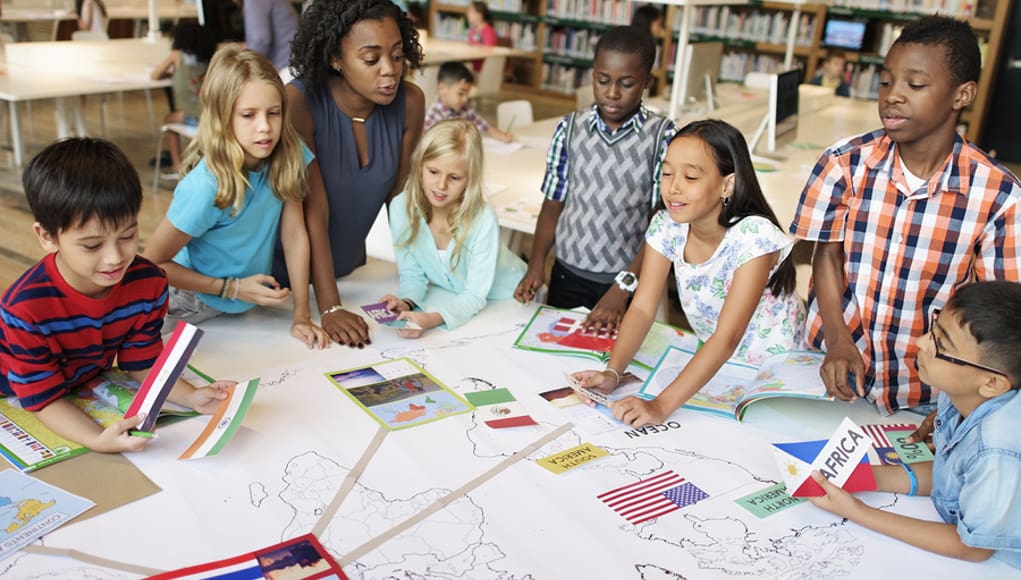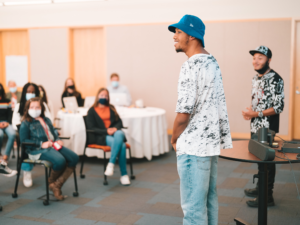Why Students Should Co-Create the Classroom from Day One

By: Tiffany Wycoff
Instead of walking into a carefully designed class that’s adorned with decorations and already set class rules, students are experiencing something new on the first day of school.
They are now setting up their own classrooms alongside teachers. It’s one important way innovative teachers are instilling agency in their students from the start.
In the book I co-authored—Blended Learning in Action—we outlined agency as one of the hallmarks of effective practice and defined it as “the act of giving learners opportunities to participate in key decisions in their learning experience.” We can set this expectation on day one by letting students actually act and exert their voice on their own environment.
I’ve seen this in both my own classroom experience and my work with other schools through LINC, the consultancy I co-founded. Setting up the room together noticeably builds a positive class culture that touches on the five hallmarks of effective blended learning practice: Personalization, Agency, Audience, Creativity, and Connectivity (PAACC).
 One teacher in Texas who regularly contributes ideas to the #BLinAction network is putting the PAACC into action as she asks new students to co-create their classroom.
One teacher in Texas who regularly contributes ideas to the #BLinAction network is putting the PAACC into action as she asks new students to co-create their classroom.
Flexible seating, relaxing screensavers, music choice, power strips, and longer station rotations were all on the list of student requests in Ms. Puckett’s class at Bridgeland High School.
Less than an hour from downtown Houston, this public school is opening its doors this fall for only its second year. Megan Puckett explains that this was one reason why she was given the leeway to do things differently. “It gave me an opportunity to not follow what everyone else was doing,” she shares. “My class is very much a conversation. At the end of every lesson we do reflection and I ask, ‘What did you like? What did you not like?”
That’s why the students felt they could ask her for nontraditional seating when they saw another class had it. Puckett showed them images of soft, foam rearrangeable Nugget cushions and they said Yes. Well, actually, they said, “That would be so cool.” Now they self-select seats each day, knowing they have a teacher-selected partner to sit with. This small move can go a long way toward instilling agency. In some cases, it can even be taken a step further by asking students to BYOC (Bring Your Own Chair) based on guidelines.
With this lens, the possibilities for co-creating the classroom with students become limitless. A few ideas for cultivating this sense of collaborative, PAACC-oriented class culture include:
Atmosphere & Decorations
- Voice: Instead of a room filled with positive messages, students find headings that set the tone for the environment but leave space for their contributions. Ex: We believe… (students fill in the wall of beliefs about the way friends should learn and interact together)
- Inspiration: On tables, they find magazines where they cut out pictures that inspire them to learn. They add these to inspiration corners or stations for choice-based discovery. Teachers use these to build an inspiration wall or sort them to create learning centers aligned with those inspirations. (Ex: adventurous pictures for Explore areas of the room; cozy pictures for Reading nooks).
Seating/Learning Spaces
- Centers: Teachers lead a discussion on which centers will be part of the basic setup and ask for suggestions on other centers. Students receive a blank paper on which to suggest seating clusters and room arrangement.
- Choice: One corner of the room could be assigned to students to design on a rotation. They choose the learning activity there, bring in the decorations and teach the class about the purpose of the station for the weeks it is there.
Routines/Expectations:
- Models: Teachers can explain the blended models which will be used in student language. Starting with just one (ex: Station Rotation) may help build understanding in a scaffolded manner. Teachers can engage students in the setting of rules/expectations for each station, from how it should look/feel/sound to how to get help if not at the teacher station.
- Peer Support: Teachers can engage students in thinking about what types of class jobs would help make sure learning is consistently the focus in class. These can range from a Tech Desk help to Chief Cheerleader. Students can apply for jobs listing their qualifications and contribute to thinking on length of term and how the jobs should rotate.
- Digital Contract: Guiding students through the creation of a digital contract is an essential component of Blended Learning success. Rather than have an honorable use policy already in place, teachers can facilitate the collaborative creation of one.
- Transitions/Choice: In blended learning, there are a lot of transitions to plan for: coming into the class, rotating on/off devices, moving between stations. Sometimes these are dictated by routines and timers, which other times the movements is more flexible by choice. Teachers can engage students in creating the expectations for transitions and a way to show accountability for choice where agency is high. For example, you may design a system where all stations are listed on a wall and students put a clothes pin with their name where they are moving.
Transitions between stations is another thing students wanted to influence in Mrs. Puckett’s class. They were getting 12-17 minutes, which wasn’t enough time according to them.
“The students would see changes in the station transitions the next day. By giving kids a voice, they felt like all voices matter,” says Puckett, who had a close connection with her class after making the transition from Salyards Middle School to Bridgeland High School with them last year. Her focus on meaningful learning is what propelled her to be named both 2011 Substitute Teacher of the Year (District Middle School Level) and 2013 Spotlight Teacher (Salyards Middle School). She reminds teachers heading into a new school year of the piece of advice that has stuck with her most: “If you can’t remember the last time you failed in your classroom, you’re not taking enough risks.”
The best way to start co-creating the classroom is to simply try one of these strategies.
By setting the standard for agency at the start of the year, we create a culture of personal accountability for self and class community. Waiting for the students to arrive also frees up some valuable time before the doors open. It’s an opportunity to shift from planning room design to planning ways to make learning more rigorous, magical and engaging.
For more, see:
- Social-Emotional Support: The Real Urgency of Blended Learning
- Personalized Learning: Lessons to Get the Message Right
- The Future of Personalized Learning
Tiffany Wycoff is Co-Author of Blended Learning in Action, and is Co-Founder of LINC (Learning Innovation Catalyst). Connect with Tiffany on Twitter @teachontheedge.
Stay in-the-know with all things edtech and innovations in learning by signing up to receive our weekly newsletter, Smart Update.







0 Comments
Leave a Comment
Your email address will not be published. All fields are required.